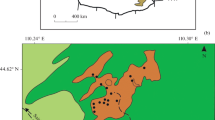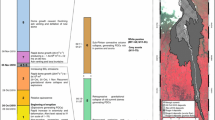Abstract
Evidence for low-pressure incongruent melting of limestone containing up to 40 wt% of silicate minerals (marly limestone) is reported from the Khamaryn–Khural–Khiid Combustion Metamorphic (CM) complex in East Mongolia. Marly limestone exposed to high-temperature metamorphism during wild coal fires has acquired a mineral assemblage consisting of gehlenitic melilite and Al-diopside-to-kushiroite-dominant clinopyroxene as main phases and rare phases of celsian, spinel, perovskite, geikielite, etc. Melting of silicate minerals and calcite produced silicate melts of different compositions and stoichiometric calcitic (CaCO3) or non-stoichiometric carbonatite-like (CaCO3 + CaO) melts. Coalescence of silicate melt drops was followed by the formation of silica-undersaturated Ca-rich and Na-bearing paralava melts. Melilite-nepheline paralavas discovered in the Khamaryn–Khural–Khiid and Nyalga CM complexes in Mongolia have exceptional features of mineralogy and chemistry due to a rare combination of P–T conditions associated with wild coal fires and combustion metamorphism: a high temperature (> 1250 °C) and fluid pressure above 4 MPa that prevented decomposition of calcite. Such paralavas from the two CM complexes are composed of similar mineral assemblages made up of melilite, clinopyroxene, plagioclase, nepheline, Fe–Ca olivines (Ca-fayalite and kirschsteinite), K-Ba feldspars (celsian and hyalophane), spinel-group minerals, and rhönite-kuratite, with broad composition variations. Paralavas of this kind have never been reported before from anywhere. Their local mineralogical and geochemical specificity may be due to variations in the composition of carbonate protolith and in physicochemical conditions above the coal fire foci (T, P, gas composition, oxygen fugacity, and melt cooling rate). Low-pressure melting of calcite and the formation of carbonate (calcitic or carbonatite-like) melts have implications for phase relations in carbonate rocks altered by high-temperature metamorphism and metasomatism, as well to the origin of carbonatites. Calcite in carbonate sediments exposed to low pressures and high temperatures (above the invariant point Q1 in the CaCO3 phase diagram) does not decompose and can melt. Correspondingly, metamorphic decarbonation reactions do not produce CaO required for the crystallization of many Ca-rich index minerals of spurrite–merwinite facies. The melting point of calcite decreases markedly with increasing H2O content in the H2O–CO2 fluid, which may lead to melting of calcite in carbonate sediments and to formation of calcite-rich carbonatites at P–T crustal conditions.






modified from Fig. 4 of Savina et al. 2020); d Model PM-normalized multielement patterns of marly limestone (calculated from paralava compositions, assuming calcite/paralava ratio = 1/1, provided that calcite is free from trace elements); e PM-normalized multielement patterns of Nyalga paralavas and clinkers (modified from Fig. 3 of Peretyazhko et al. 2018)










Similar content being viewed by others
References
Anovitz LM, Blencoe JG (1999) Dry melting of high albite. Amer Miner 84:1830–1842. https://doi.org/10.2138/am-1999-11-1210
Baker EH (1962) Calcium oxide-carbon dioxide system in the pressure range 1–300 atmospheres. J Chem Soc. https://doi.org/10.1039/JR9620000464
Burns S, Hargreaves JSJ, Hunter SM (2007) On the use of methane as a reductant in the synthesis of transition metal phosphides. Catal Comm 8:931–935. https://doi.org/10.1016/j.catcom.2006.10.001
Deer WA, Howie RA, Zussman J (1992) An introduction to the rock-forming minerals. Essex: longman scientific and technical. 2nd ed. Wiley, New York, 696 pp https://trove.nla.gov.au/version/24154290
Durand C, Baumgartner LP, Marquer D (2015) Low melting temperature for calcite at 1000 bars on the join CaCO3–H2O–some geological implications. Terra Nova 27:364–369. https://doi.org/10.1111/ter.12168
El-Meliegy EAM, Abdel-Hammed SAM (2005) Enstatite-celsian glass ceramics. Mater Charact 55:28–34. https://doi.org/10.1016/j.matchar.2005.02.005
Erdenetsogt B, Lee I, Bat-Erdene D, Jargal L (2009) Mongolian coal-bearing basins: geological settings, coal characteristics, distribution, and resources. Int J Coal Geol 80:87–104. https://doi.org/10.1016/j.coal.2009.08.002
Ferguson JB, Buddington AF (1920) The binary system åkermanite-gehlenite. Am J Sci 50:131–140
Fernández-Díaz L, Fernández-González Á, Prieto M (2010) The role of sulfate types in controlling CaCO3 polymorphism. Geochim Cosmochim Acta 74:6064–6076. https://doi.org/10.1016/j.gca.2010.08.010
Fuerstenau MC, Sben CM, Palmer BR (1981) Liquidus temperatures in the CaCO3–Ca(OH)2–CaO and CaCO3–CaSO4–CaS ternary systems: II. Ind Eng Chem Process Design Dev 20(3):443–445
Gittins J, Tuttle OF (1964) The system CaF2–Ca(OH)2–CaCO3. Am J Sci 262:66–75
Grapes R (2011) Pyrometamorphism, 2nd edn. Springer, Berlin, p 365. https://doi.org/10.1007/978-3-642-15588-8
Greenwood JP (1999) Melting kinetics of CAIs: stability of fassaite during flash heating. In: 62nd Annual Meteoritical Society Meeting, July 11–16. Johannesburg, South Africa, Abstract 5230.
Greenwood JP, Hess PS (1998) Congruent melting of albite: theory and experiment. J Geophys Res 103(B12):29815–29828. https://doi.org/10.1029/98JB02300
Hammouda T, Laporte D (2000) Ultrafast mantle impregnation by carbonatite melts. Geology 28(3):283–285. https://doi.org/10.1130/0091-7613(2000)28%3c283:UMIBCM%3e2.0.CO;2
Hu G, Dam-Johansen K, Wedel S, Hansen JP (2006) Review of the direct sulfation reaction of limestone. Prog Energy Combust Sci 32:386–407. https://doi.org/10.1016/j.pecs.2006.03.001
Illerup JB, Dam-Johansen K, Lunden K (1993) High-temperature reaction between sulfur dioxide and limestone–VI. The influence of high pressure. Chem Eng Sci 48 (11): 2153–2157. https://doi.org/10.1016/0009-2509(93)80089-9
Irving AJ, Wyllie PJ (1973) Melting relationships in CaO–CO2 and MgO–CO2 to 36 kbar with comments on CO2 in the mantle. Earth Planet Sci Lett 20:220–225. https://doi.org/10.1016/0012-821X(73)90161-1
Ivanov BA, Deutsch A (2002) The phase diagram of CaCO3 in relation to shock compression and decomposition. Phys Earth Planet Inter 129:131–143. https://doi.org/10.1016/S0031-9201(01)00268-0
Jones AP, Genge M, Carmody L (2013) Carbonate melts and carbonatites. Rev Mineral Geochem 75:289–322. https://doi.org/10.2138/rmg.2013.75.10
Kechid S, Parodi GC, Pont S, Oberti R (2017) Davidsmithite, (Ca,□)2Na6Al8Si8O32: a new, Ca-bearing nepheline-group mineral from the Western Gneiss Region, Norway. Eur J Mineral 29:1005–1013. https://doi.org/10.1127/ejm/2017/0029-2667
Keller J, Zaitsev AN, Wiedenmann D (2006) Primary magmas at Oldoinyo Lengai: the role of olivine melilitites. Lithos 91(1):150–172. https://doi.org/10.1016/j.lithos.2006.03.014
Kerley GI (1989) Equations of state for calcite minerals. I. Theoretical model for dry calcium carbonate. High Press Res 2:29–47. https://doi.org/10.1080/08957958908201030
Kushiro I, Schairer JF (1964) The join diopside–åkermanite. Carnegie Inst Wash Year Book 63:132–133
Lavrent’ev YuG, Karmanov NS, Usova LV (2015) Electron probe microanalysis of minerals: microanalyzer or scanning electron microscope? Russ Geol Geophys 56 (8): 1154–1161.https://doi.org/10.1016/j.rgg.2015.07.006
Lindberg D, Chartrand P (2009) Thermodynamic evaluation and optimization of the (Ca + C + O + S) system. J Chem Thermodyn 41:1111–1124. https://doi.org/10.1016/j.jct.2009.04.018
Lustrino M, Ronca S, Caracausic A, Bordenca CV, Agostinie S, Faraone DB (2020) Strongly SiO2-undersaturated, CaO-rich kamafugitic Pleistocene magmatism in Central Italy (San Venanzo volcanic complex) and the role of shallow depth limestone assimilation. Earth Sci Rev 208:103256. https://doi.org/10.1016/j.earscirev.2020.103256
Martin B, Kushiro I (1991) Immiscibility synthesis as an indication of cooling rates of basalts. J Volcan Geoth Res 45:289–310. https://doi.org/10.1016/0377-0273(91)90064-7
McDonough WE, Sun S (1995) The composition of the Earth. Chem Geol 120(3–4):223–253. https://doi.org/10.1016/0009-2541(94)00140-4
Melluso L, Conticelli S, D’antonio M, Mirco NP, Saccani E (2003) Petrology and mineralogy of wollastonite- and melilite-bearing paralavas from the Central Apennines, Italy. Am Miner 88 (8): 1287–1299. https://doi.org/10.2138/am-2003-8-911
Melluso L, Conticelli S, Gennaro R (2010) Kirschsteinite in the Capo di Bove melilite leucitite lava (cecilite), Alban Hills. Italy Mineral Mag 74(5):887–902. https://doi.org/10.1180/minmag.2010.074.5.887
Mendybaev RA, Richter FM, Davis AM (2006) Reevaluation of the åkermanite–gehlenite binary system. In: 37th Annual Lunar and Planetary Science Conference, March 13–17. League City, Texas, Abstract 2268.
Okumura T, Kim H-J, Kim J-W, Kogure T (2018) Sulfate-containing calcite: crystallographic characterization of natural and synthetic materials. Eur J Mineral 30:929–937. https://doi.org/10.1127/ejm/2018/0030-2772
Onuma K, Moridaira H (1991) The system diopside-åkermanite-gehlenite at 1 atm. J Min Petr Econ Geol 86:554–559. https://doi.org/10.2465/ganko.86.554
Osborn EF, Schairer JF (1941) The ternary system pseudowollastonite–åkermanite–gehlenite. Am J Sci 239:715–763. https://doi.org/10.2475/ajs.239.10.715
Peretyazhko IS (1996) CRYSTAL—applied software for mineralogist, petrologist, and geochemists. Zap Ros Mineral Obshch 3:141–148
Peretyazhko IS, Savina EA, Khromova EA (2017) Minerals of the rhönite-kuratite series in paralavas from a new combustion metamorphic complex of Choir-Nyalga Basin (Central Mongolia): chemistry, mineral assemblages, and formation conditions. Mineral Mag 81(4):949–974. https://doi.org/10.1180/minmag.2016.080.143
Peretyazhko IS, Savina EA, Khromova EA, Karmanov NS, Ivanov AV (2018) Unique clinkers and paralavas from a new Nyalga combustion metamorphic complex in central Mongolia: mineralogy, geochemistry, and genesis. Petrology 26(2):181–211. https://doi.org/10.1134/S0869591118020054
Persikov ES, Bukhtiyarov PG (2004) Experimental study of the mechanisms of calcite and dolomite melting at high fluid pressures. In: Informational Bulletin of the Annual Seminar of Experimental Mineralogy, Petrology and Geochemistry. http://www.scgis.ru/russian/cp1251/h_dgggms/1-2004/informbul-1_2004/term-5e.pdf
Pertsev NN (1977) High-temperature metamorphism and metasomatism of carbonate rocks. Nauka, Moscow, pp 256 (in Russian).
Pokrovskii PV (1949) Ammonium chloride from the Khamaryn–Khyral–Khiid brown coal field in Mongolia. Zap Ros Min Obshch 3:38–45
Reverdatto VV (1970) Facies of contact metamorphism. Nedra, Moscow, pp 271 (in Russian).
Rossi G, Oberti R, Smith DC (1986) The crystal structure of lisetite, CaNa2Al4Si4O16. Am Min 71:1378–1383
Savina EA, Peretyazhko IS, Khromova EA, Glushkova VE (2020) Melted rocks (clinkers and paralavas) of Khamaryn-Khural-Khiid combustion metamorphic complex in Eastern Mongolia: mineralogy, geochemistry and genesis. Petrology 28(5):431–457. https://doi.org/10.1134/S0869591120050057
Schairer JF (1950) The alkali-feldspar join in the system NaAlSiO4–KAlSiO4–SiO2. J Geol 58(5):512–517. https://doi.org/10.1086/625759
SungY-M A-W (2000) Sintering and crystallization of off-stoichiometric BaO–Al2O3–SiO2 glasses. J Mater Sci 35(19):4913–4918. https://doi.org/10.1023/A:1004870022862
Tracy RJ, Frost BR (1991) Contact metamorphism. Chapter 5. Phase equilibria and thermobarometry of calcareous, ultramafic and mafic rocks, and iron formations. Rev Mineral Geochem 26: 207–289. https://doi.org/10.1515/9781501509612-008
Treiman A (1995) Ca-rich carbonate melts: a regular-solution model, with applications to carbonatite magma + vapor equilibria and carbonate lavas on Venus. Am Min 80(1):115–130. https://doi.org/10.2138/am-1995-1-212
Vuilleumier R, Seitsonen A, Sator N, Guillot B (2014) Structure, equation of state and transport properties of molten calcium carbonate (CaCO3) by atomistic simulations. Geochim Cosmochim Acta 141:547–566. https://doi.org/10.1016/j.gca.2014.06.037
Wyllie PJ, Boettcher AL (1969) Liquidus phase relationships in the system CaO–CO2–H2O to 40 kbar pressure with petrological applications. Am J Sci 267A: 489–508. https://resolver.caltech.edu/CaltechAUTHORS:20160120-155840656
Wyllie PJ, Tuttle OF (1960) The system CaO–CO2–H2O and the origin of carbonatites. J Petrol 1(1):1–46. https://doi.org/10.1093/petrology/1.1.1
Acknowledgements
We wish to thank our colleagues for analytical work: A. N. Sapozhnikov from the Vinogradov Institute of Geochemistry (IGC, Irkutsk) for XRD identification of minerals, and A. N. Kozlov from the Melentiev Energy Systems Institute (ESI, Irkutsk) for thermal analysis of rock sample. The manuscript profited much from constructive criticism by two anonymous reviewers. The study was carried out as part of Basic Research Program 0284-2021-0007 of the Russian Academy of Sciences and was supported by Grant 075-15-2019-1883 from the Ministry of Science and Higher Education of the Russian Federation.
Author information
Authors and Affiliations
Corresponding author
Additional information
Communicated by Mark Ghiorso.
Publisher's Note
Springer Nature remains neutral with regard to jurisdictional claims in published maps and institutional affiliations.
Supplementary Information
Below is the link to the electronic supplementary material.
Rights and permissions
About this article
Cite this article
Peretyazhko, I.S., Savina, E.A. & Khromova, E.A. Low-pressure (> 4 MPa) and high-temperature (> 1250 °C) incongruent melting of marly limestone: formation of carbonate melt and melilite–nepheline paralava in the Khamaryn–Khural–Khiid combustion metamorphic complex, East Mongolia. Contrib Mineral Petrol 176, 38 (2021). https://doi.org/10.1007/s00410-021-01794-5
Received:
Accepted:
Published:
DOI: https://doi.org/10.1007/s00410-021-01794-5





